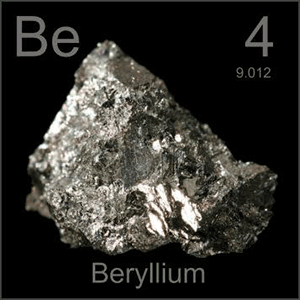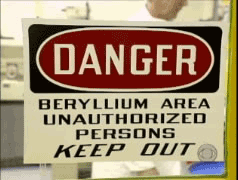Learn about available benefits for sick workers.
Chronic Beryllium Disease & EEOICPA
 Beryllium
Beryllium
Beryllium is a metallic element found naturally in rocks, coal, and everyday soil. Due to the metal’s incredible strength and extreme heat resistance it is often used in the nuclear industry. Many Department of Energy nuclear weapons facilities worked with beryllium exposing workers to dust and fumes.
Employees who have become sick due to beryllium exposure may be eligible for compensation and medical coverage under the Energy Employees Occupational Illness Compensation Program Act (EEOICPA).
What is Beryllium Disease?
Beryllium disease is an allergic reaction to the inhalation of beryllium dust or fumes. A single, minor encounter with beryllium can lead to health complications. An individual can start to show symptoms immediately or many years later; typically the disease develops slowly.
Greater levels of exposure do not necessarily increase the risk of allergic reaction. However, beryllium is carcinogenic and can also lead to lung diseases or cancer. Extended exposure can increase this risk.
Chronic Beryllium Disease (CBD)
CBD is a progressive loss of lung function and inhibition of normal lung function. Not everyone will have an allergic reaction to beryllium. The CDC estimates around 10% of workers exposed to beryllium are at risk. Beryllium sensitization refers to individuals who have an allergic reaction to beryllium. These individuals are susceptible to Chronic Beryllium Disease.
CBD Symptoms:
- Breathing difficulties
- Coughing
- Chest pain
- General weakness
- Pulmonary fibronodular disease
- Weight loss
CBD Treatment
There is no cure for Chronic Beryllium Disease. Treatment is typically aimed at reducing inflammation and slowing the disease progression. Prednisone or similar drugs are often prescribed by doctors to curb immune system response to beryllium and reduce symptoms.
Disease Detection

A beryllium lymphocyte proliferation test (BeLPT) can measure whether or not an exposed worker is allergic to beryllium. BeLPT tests have been found to be highly specific with the ability to identify CBD prior to any symptoms.
Chronic beryllium disease is typically confirmed with additional tests including chest x-rays, lung biopsy, scans or lung function tests. In the past CBD has commonly been confused and misdiagnosed as Sarcoidosis.
CBD Clinical Indications:
- Granulomas or lesions typically on the lungs
- Enlargement of liver
- Enlargement of spleen
- Right heart enlargement
- Kidney Stones
EEOICPA & Chronic Beryllium Disease
According to the Department of Labor’s official CBD pamphlet:
What are the Eligibility Criteria for CBD under Part B?
The medical evidence required to support a diagnosis of CBD under Part B differs based on the date of diagnosis. If CBD was diagnosed on or after January 1, 1993, the medical documentation must include: an abnormal beryllium lymphocyte proliferation test (BeLPT), or an abnormal Energy beryllium lymphocyte transformation test (BeLTT), performed on either blood or lung lavage cells; lung pathology consistent with CBD; plus any of the following:
- A lung biopsy showing granulomas or a lymphocytic process consistent with CBD
- A Computerized Axial Tomography (CAT) scan showing changes consistent with CBD
- A pulmonary function study or exercise tolerance test showing pulmonary deficits consistent with CBD
If CBD was diagnosed before January 1, 1993, the medical documentation must include a history of, or epidemiological evidence of, exposure to beryllium, plus three of the following criteria:
- Characteristic chest X-ray or computed tomography (CT) abnormalities
- Restrictive or obstructive lung physiology testing or diffusing lung capacity defect
- Lung pathology consistent with CBD
- Clinical course consistent with a chronic respiratory disorder
- Immunologic tests showing beryllium sensitivity (skin patch test or beryllium blood test)
What are the Benefits for CBD accepted under Part B?
- Employees may receive a lump sum payment of $150,000 and payment of medical expenses from the filing date of the claim
- Eligible survivors may receive a lump sum payment of $150,000 (divided equally)
What are the Eligibility Criteria for CBD under Part E?
Eligible DOE contractor employees must have medical evidence to support a diagnosis of CBD:
- A rationalized medical report including a diagnosis of CBD from a qualified physician (a diagnosis of sarcoidosis will qualify as CBD, where there is beryllium exposure), and
- A qualified physician’s opinion that that exposure to beryllium was “at least as likely as not” a significant factor in causing, contributing to, or aggravating the employee’s CBD
- DOE contractor employers who receive CBD acceptances under Part B are presumed eligible under Part E for their CBD
- A positive BeLPT result is necessary to establish beryllium sensitivity
What are the Benefits for CBD accepted under Part E?
- Employees receive payment of medical expenses beginning on the date the claim is filed
- Employees are entitled to payments based on the level of their whole body impairment and/or years of qualifying wage loss, up to a maximum of $250,000
- Eligible survivors may receive a lump sum payment of $125,000, and if the employee had wage loss from CBD, possibly additional wage-loss compensation (divided equally)
Have Questions? Call Us (800) 718-5658

Get No-Cost Home Health Care!
Need in-home medical assistance? Remain at Home is a proud to serve nuclear workers under EEOICPA. Call us today at (800) 718-5658 or use the form below!

